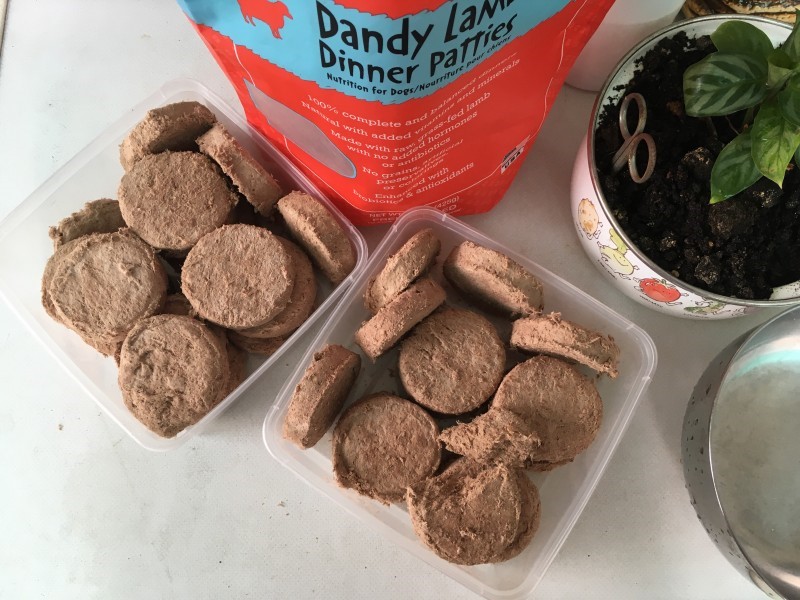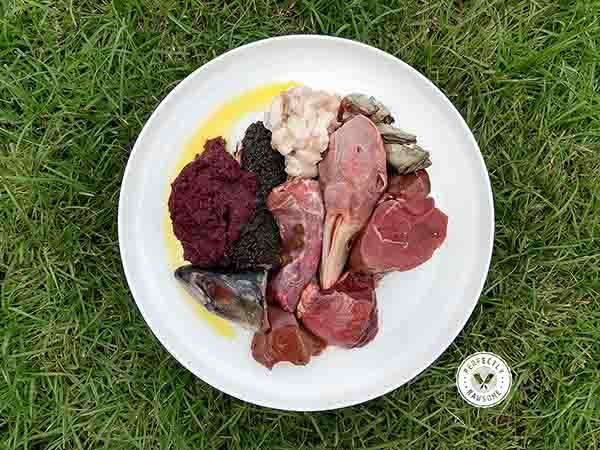French Bulldog Feeding: The Raw Diet
Should I Feed My French Bulldog the Raw Food Diet?
All dog owners want the absolute best for their furry companions to make sure they stick around for as long as possible and live a healthy, happy and active life.
A balanced, biologically appropriate diet is the first step towards achieving that goal. Historically, dry dog kibble and canned dog food were the only choices on the market. But over the years, people became more familiar with different options like the fresh food or raw food diets.
In this blog we will dive deeper into the raw food diet, it’s benefits, risks and frequent misconceptions.
What is the raw dog food diet?
The B.A.R.F diet stands for two common phrases: ‘Biologically Appropriate Raw Food’ and ‘Bones and Raw Food’. Founded by veterinarian and nutritionist Dr. Ian Billinghurst, the principle is to feed dogs the diet they evolved to eat—a raw diet composed of meats and greens that are fresh, uncooked and wild.
The genetic makeup of domesticated dogs supports this. From Boston Terriers to St. Bernards, dogs are essentially the same as their ancestors, gray wolves.
As direct descendants of wolves, dogs are simply not genetically optimized to consume the 50% carbohydrate content of today’s commercial kibbles.
The recommended guidelines for a BARF diet consists of 70% muscle meat, 10% raw edible bone, 7% vegetables, 5% liver, 5% other secreting organ, 2% seeds or nuts, and 1% fruit.
What are the benefits of raw feeding?
• Firmer stools
• Improved digestion
• Healthier skin and coat
• Reduced allergy symptoms
• Leaner, more muscular build;
Nearly 60% of dogs are overweight or obese based on body condition scoring, which leads to a number of related conditions.
There have been many reports of improved health when chronically ill pets were switched from a commercial product to a raw dog food.
The downsides of raw feeding
I personally think the benefits outweigh the downsides, but it comes down to every individual and their budget as well as their household situation.
• First downside would be the inconvenience of feeding raw vs. feeding kibble. Raw food has a shorter shelf life and needs to be refrigerated/freezed at all times.
• Second is the possibility of contamination – for humans. The dogs have a short and acidic digestive system, so they aren’t susceptible to Salmonella or E-coli infections. Always wash your food after handling raw food. Wash the dog bowl with soap and warm water right after feeding.

Frequent Misconceptions About Raw Feeding
1. Raw meat is contaminated/infested with parasites
Pick meat that is labeled as “human grade”, that meat is inspected and clear of parasites. I would however steer away from wild meat (bear, beaver, wild pig, etc.). Bacteria is found everywhere, even on kibble, but dogs have a short digestive track and usually aren’t affected by Salmonella or E-coli, like I mentioned before.
**2. My veterinary advised against raw feeding and suggested the science diet instead. **
You have to understand that “veterinarian” doesn’t equal “nutritionist”. Most vets have very little nutritional training, and what they get in school is funded by the pet food companies.
Vets that don’t understand the dietary needs of dogs (and cats) will recommend kibble or canned food, so that each meal is complete and balanced. They will tell you that your dog will get salmonella or e-coli from raw meat, etc..
Dogs eat poop, road kill and lick their behinds every day. . Their system is different from ours. If we ate the stuff they did, we would for sure get very sick.
_ Dogs have a short digestive system made to handle raw meat and bones(raw bones, NEVER COOKED BONES), the bacteria that is present isn’t a problem for a healthy dog. _
3. Is kibble bad for my dog? My dog has been eating it for years and had no issues.
Where do I start with this one.. First dogs don’t have a nutritional need for ingredients like wheat, corn, etc and the grains and fillers in the commercial dog food are often the root of allergies and digestion issues.
Most commercial dog foods also have artificial color, sugar, artificial flavoring, too much salt, etc.. The goal of adding all these things is to make them flavorful and appealing to your dog.
Kibble is cooked on extremely high temperatures which destroys most of the nutrients that are beneficial to your dog (enzymes, vitamins, beneficial bacteria, fatty acids). The processing kibble goes through makes all the dogs internal organs work harder to extract the nutrients that have survived the extruding process.
The kibble industry of course improved a lot. There are many “grain free” and “organic” kibble options, but at the end of the day you are still feeding your dog a highly processed, nutritionally low meal.
** Dogs just like human can SURVIVE on a low quality diet(read fast food), but they can’t THRIVE on it. Feed your dog a species appropriate nutrition and watch him live a long, healthy, issue free life.**
How To Raw Feed Your French Bulldog
1. Frozen and Dehydrated Raw Food Brands
Pet Smart and Pet Co carry most of these option. The difference between frozen and freeze dried/dehydrated is the storing process.
You don’t have to keep the dehydrated raw food in the fridge and it’s completely safe so carry it around. It’s best to re-hydrate is before serving by using bone broth, warm water, goat milk..
- Instinct Frozen Raw Pet Food
- Primal Dehydrated Raw Food
- Stella&Chewy’s
- Nulo Freeze Dried Raw
- The Honest Kitchen
- Spot Farms
- Visionary Keto Pet Foods

2. Raw Food Subscriptions
If you aren’t to fond of preparing your own meal, or confused about creating a balanced meal you can always rely on experts to do it for you. Below are some raw food subscription services that will bring the food to your door.
3. Preparing Your Own Raw Food
It’s true, raw food subscriptions and food brands tend to be more expensive, but you can choose the cheaper route and prepare the meals yourself. You definitely need to be careful and do a lot of research to make sure you are balancing the nutrients correctly.
What should the basic raw meal structure look like:
• 1 ½ cups of raw meat, partially on the bone
• ½ veggies and fruit
• Multivitamin/mineral product
• Omega 3 in a form of fish oil or general omega 3 supplement
**How much should you feed? **
An adult dog needs to eat just over 2% of his bodyweight in food each day (whether it’s raw dog food, or homemade food that you’re cooking for him).
So, for a 10lb dog that’s just under 1/4lb of food; for a 50lb dog just over 1lb, and for a 100lb dog about 2.5lbs.
You can use this guide to figure out how much your dog needs, but of course bear in mind that all dogs are different and that these figures are guidelines only.
• Ratio can be 75% - 95% meat/bones/organs and 5% -25% vegetables
• The bones in any raw dog food recipe should have an equal amount of meat and bone (ie a 1:1 ratio). Big bones with just a little bit of meat aren’t nearly as good as smaller bones with more meat on them.
• Overall bone to meat ratio can be approx 1:3

What kind of meat you should use:
• Chicken - chicken necks, thighs, wings and even feet are great choices
• Turkey - as above
• Duck - as above
• Lamb
• Beef
• Rabbit
• Venison
• Wild game birds such as Pheasant or Partridge
• Organ Meat such as liver, kidneys and so on are excellent, but rich, so use sparingly at first
• Whole fish of just about any kind are fine, but raw salmon often isn’t recommended
Safe to use vegetables:
• Brussel Sprouts
• Carrots
• Cauliflower
• Okra
• Green Beans
• Peas
• Pumpkin
• Squash
• Romaine Lettuce
• Parsley
• Celery
• Sweet Potatoes
Safe to use fruits:
• Apples (pitts are poisonous, make sure to remove them)
• Bananas
• Pears
• Strawberries
• Blueberries
Extra ingredients you could add:
Other ingredients that can be used to add variety and extra nutritional value to raw dog food recipes. They do not need to be added daily, and once or twice a week for most is generally enough…
• Kefir as a probiotic
• Raw Eggs - including the shells which need to be ground to a fine powder
• Almonds (NOT Macadamia Nuts)
• Sunflower seeds
• Wheatgrass
• Kelp
Conclusion
Hopefully this blog convinced you or at least opened your mind to benefits of raw feeding. Like I mentioned before, I do understand that kibble is way more convenient, but the BARF diet is a diet closest to your dogs origin and proven to help maintain longevity.



